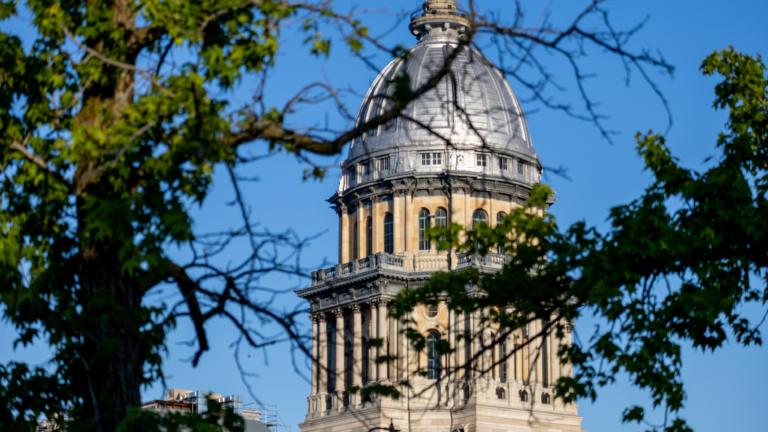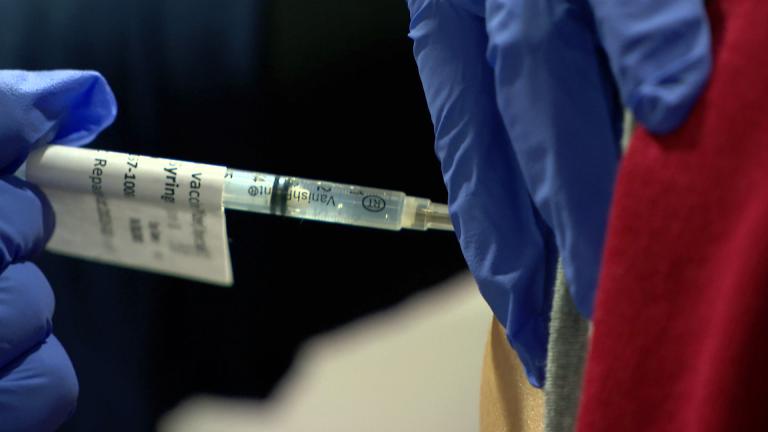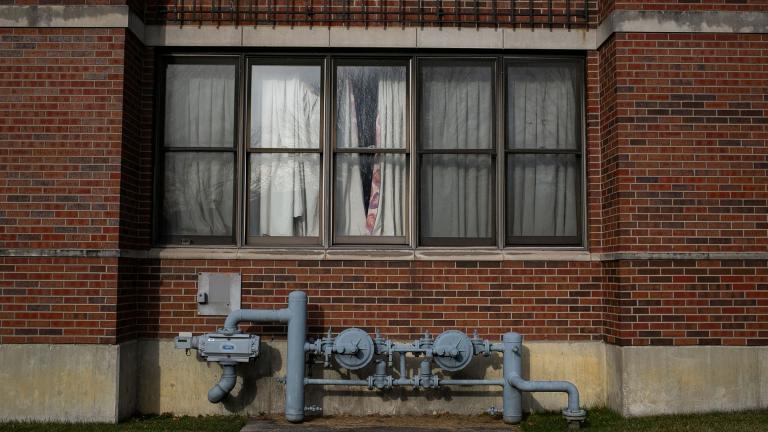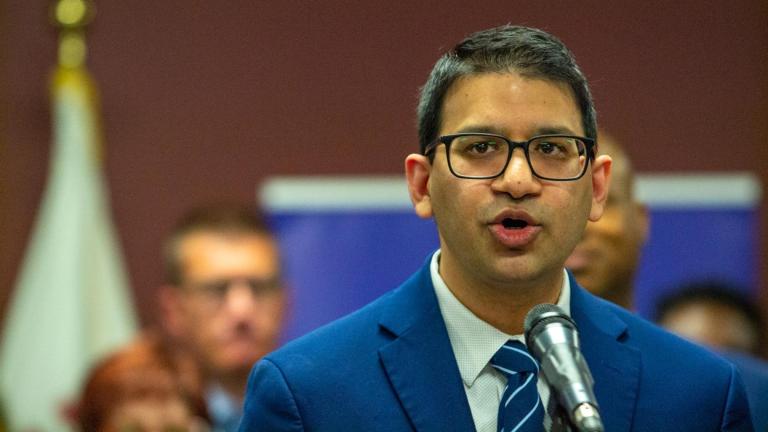Public health workers spent the last three years on the frontlines of the battle against COVID-19.
From information campaigns to the massive logistical challenges of testing and vaccine rollouts, workers dealt with a health crisis on a never-before-seen scale.
With more than a million people dying since the disease was first detected in the U.S., there was an enormous amount of work to do and seemingly never enough people to do it.
Yet the Illinois Department of Public Health (IDPH) saw the total number of paid employees drop by 6.25% to 1,409 last year, and overall pay fell by 2%, according to records kept by the Illinois comptroller’s office.
Is the change a sign the state is shifting some resources away from public health?
Mike Claffey, IDPH spokesperson, said the department’s headcount dropped about 2% at the end of the latest fiscal year from 1,206 to 1,181. He attributed the decrease in spending to a reduction in overtime.
“As we continue our efforts to protect the public from COVID-19, we are also focusing on the full depth and breadth of public health, re-prioritizing issues like chronic disease, cancer, mental health/substance abuse, and environmental health, while maintaining a strong commitment to controlling infectious diseases,” Claffey responded in a statement.
IDPH wasn’t the only state department that saw employment shifts last year. Data show many state agencies and government departments were also affected by employee resignations in the past year.
Records from the comptroller obtained and analyzed by WTTW News show how many employees collected a check from each agency over the course of a calendar year, and what each employee was paid. Actual headcount, or the number of employees working at a time, provides further context to compare employee figures each year.
Taken in totality, these records provide a glimpse into how Illinois leaders utilize the state budget and have shifted staffing priorities in recent years.
The state paid employees $5.3 billion in 2022, according to new Illinois comptroller data, up about 3.5% from the previous year. The total number of employees was marginally smaller than in 2021.
Staffing the COVID-19 Fight
In the midst of a pandemic that claimed more than 36,000 lives and tallied 4 million of cases in Illinois, a workforce reduction in public health may seem counterintuitive. However, researcher JP Leider said the figures follow a recent trend in public health — an exodus of public sector employees.
“You had people in public health getting bullied, harassed, threatened, and their professional credentials and decisions being questioned,” said Leider, the director of the Center for Public Health Systems at the University of Minnesota. “Then put the stressors of actually responding to the pandemic on top of it. That’s what state and local public health have had to deal with for the past three years.”
Employees across the country planned to retire before the pandemic but delayed to help fight COVID-19, Leider said. Many have since left their positions, citing stress and burnout among other factors.
Chart: Records show almost one out of five Department of Public Health employees who were working in 2021 left before 2022. Actual headcount, or the number of employees working at a time, shows the number of employees working at one time in the department. The difference between the two figures helps illustrate turnover in the agency.
Leider is particularly concerned about the loss of experience and knowledge connected to those exits, and views a national surge in public health employees during the pandemic as not making up for the volume lost since the Great Recession. He said people should see public health staffing issues the same way they would high turnover in fields like public safety and education.
Records from the comptroller show almost one out of five Illinois Department of Public Health employees who were working in 2021 left before 2022, and a smaller number of employees started in 2022 than left in 2021.
“If your public safety functions are turning over at an incredible rate, what does that mean for your health protections in your state or in your county?” Leider said. “What do we need to do to get that down, support our staff and keep them so that we can make sure we have public health protections?”
Gov. J.B. Pritzker plans to increase staffing for nurse surveyors involved in licensure, workers dealing with ongoing COVID-19 concerns and key administrative positions, Senior Deputy Press Secretary Alex Gough said.
“It’s no secret that the pandemic response resulted in high burnout for employees who were on the front lines,” Gough said. “The administration has made progress to ensure we have the appropriate amount of staff to do the day to day work at IDPH.”
Federal funding for IDPH is expected to drop by $1 billion in the 2024 fiscal year, shifting the fight against COVID-19 from a state’s public health system to the traditional health care delivery, Gough said.
Illinois recognizes the difficulty in government to compete for a smaller pool of workers with higher wages in the private sector driving a tight labor market in many fields, Gough said.
A Smaller Prison Population
Another more predictable drop in staffing took place in the Department of Corrections (IDOC). The prison population decreased 34% since 2005, according to department data, and employees in those facilities followed suit.
Despite the 4% decrease in total employees in 2022, total payroll for the department rose more than $33.3 million, an increase of about 3.5%. The rise is driven by contractually obligated raises and overtime, according to Gough. Organized labor in the department is in negotiations for the upcoming fiscal year and beyond, according to IDOC.
IDOC is working to hire at facilities across the state, according to the department and the governor’s office.
“The department has worked to reduce its overall population of individuals in custody, which has helped alleviate challenges from the staffing shortages that are occurring nationwide,” IDOC spokesperson Naomi Puzello said.
The total number of people in custody was 28,963 at the end of February 2023, according to IDOC, up about 8% from the same time last year. Parole caseload was down 6.8% to 17,711 in the same time period.
State Police, AG’s Office Increases
Not all agencies were losing employees in 2022. The Illinois State Police headcount grew by a marginal figure between 2022 and 2021, while compensation spiked by more than $13 million. The increase was attributable to contractually guaranteed raises.
State police added more than 350 new employees in 2022, according to the comptroller data.
“Since taking office the Governor has invested in graduating 16 cadet classes and his FY24 proposed budget includes funding for another two cadet classes that will add 200 troopers to the ranks,” Gough said in a statement.
The number of total employees for the Illinois Attorney General’s office also grew 16.3% last year. Compensation grew about $6 million, according to records from the comptroller.
Budget documents show the office’s headcount as flat between the 2021 and 2022 fiscal years. The headcount was 824 as of December 31, according to the office.
When Attorney General Kwame Raoul first took office, the office had the highest attrition rate of all attorneys general in the country, according to a National Association of Attorneys General survey. While the attrition rank improved as of the most recent survey in 2020, the office is still in the top third for highest turnover, according to Press Secretary Jamey Dunn-Thomason.
Raoul has a number of important matters on his plate as the state’s chief law enforcement officer. With complicated cases including pushback following the overturn of Roe v. Wade, a state assault weapons ban, the battle over the SAFE-T Act and dozens of lawsuits regarding pandemic-related measures, the office is at the center of critical case law.
Private law firms and even other government employers often offer better compensation with a lighter workload, Dunn-Thomason said, challenging recruiting and retention efforts.
DCFS Continues Staffing Growth
The Department of Children and Family Services gained more than 100 employees between 2021 and 2022, records show. This mirrors figures in the governor’s proposed budget, which shows a 4.3% increase in headcount for the department for the 2022 fiscal year. Headcount for the department jumped by almost 500 employees since the 2017 fiscal year, according to state records.
Total payroll rose about $26 million in 2022. The increase in individual pay was driven mainly by cost of living and step increases with the agency increasing child protection and bilingual employees over the past year, according to a statement from DCFS. Step increases are paid to union staff, which represents 88% of the department.
“After decades of understaffing and disinvestment, the department has been able to reach its highest headcount in 15 years,” according to the statement.
DCFS, which protects abused or neglected children, has come under fire in recent years for issues including some children in the department’s care kept in long-term psychiatric or juvenile detention settings beyond medical necessity after they have been cleared for release. DCFS pushed back on this characterization, calling it, “simply not true.”
“The reality is that finding placements for these children, who require significant and thoughtful transition services and placements is often not easy and requires a great deal of time as these placements have very limited capacity,” DCFS spokesperson Heather Tarczan said.
Chart: Actual headcount, or the number of employees working at a time, shows the number of employees working at one time in the department. The difference between the two figures helps illustrate turnover in the agency.
A Chicago Tribune/ProPublica report from 2020 showed the department placing kids in dangerous facilities in other states because of a lack of options in Illinois.
Cook County Public Guardian Charles Golbert, who has been with the office for more than three decades, is skeptical the increased staff will improve performance by DCFS.
“Whatever number of people they'll tell you that they’ve hired, whatever it is, they’ve lost the same number,” Golbert said.
The governor’s office disputed that characterization while emphasizing staffing trends.
“The net number of workers at DCFS is at the highest number in more than a decade. Any statement that implies that number is not actually higher than it was in the previous year is wrong because numbers do not lie,” said Jordan Abudayyeh, deputy chief of staff for communications and media strategy.
DCFS acknowledged the difficulty COVID-19 put on the agency and other child welfare providers throughout the state, but did not answer a question about agency turnover, saying instead it was not uncommon to find employees celebrating 20, 25 or even 30-year anniversaries with the department. About 475 employees who were with the department in 2021 left DCFS before 2022.
The Public Guardian’s Office represents about 7,000 children in their cases in the court in Cook County. Golbert said the state eliminated 500 beds during former Gov. Bruce Rauner’s term, and expanded its therapeutic foster care capacity by only a few dozen beds since.
Golbert said DCFS has failed those in its care, “in every major significant way they can.”
Video: WTTW News correspondent Amanda Vinicky breaks down DCFS spending and employment data.
The department included $87 million in the 2023 fiscal year to increase provider’s staff wages to be more competitive and closer in line with starting state wages, Gough said.
The governor’s office identified other budget increases to improve the functionality of DCFS, including $25 million to help providers build capacity, and more than $60 million in the past several years to make needed upgrades to the IT systems.
For the state workforce, retention was identified as a key priority of the administration, and the governor’s office highlighted a potential update by the General Assembly to the “archaic Personnel Code” in Illinois this session.
Further staffing priorities for the coming year will be revealed as the budget approval process moves forward in the General Assembly in the coming weeks. Lawmakers are currently scheduled to wrap up their work and adjourn by May 19.
Note: This story was first published April 14 and was updated with additional comment from the governor’s office. Video was added April 18 and 21.








